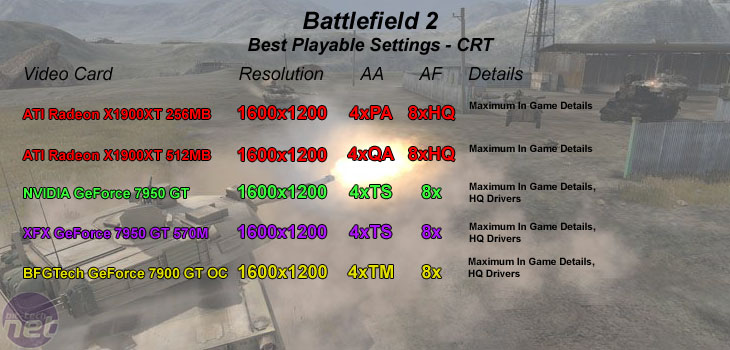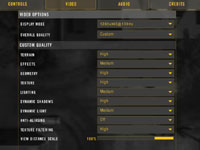CRT Gaming:
For gameplay evaluations on a 24" widescreen monitor, please head straight to our widescreen performance section.Battlefield 2
Publisher: Electronic ArtsBattlefield 2 features an all-new game engine based on the DirectX 9.0 API. There is no Shader Model 3.0 support, but the majority of hardware will use a Shader Model 2.0++ mode that includes support for Normal Maps, Parallax Mapping, Full-Resolution Dynamic Shadowing, Post Processing and Fog.
The game will look the same on both NVIDIA and ATI hardware, so there is no advantage of choosing one over the other in image quality related circumstances. The only major difference is that Ultra Shadow 2 is utilised on NVIDIA's hardware, while the shadowing on ATI hardware is done using a slightly different technique.
We patched the game to version 1.4 and then played three five-minute segments of the 'Strike at Karkand' map, reporting the median frame rate. We found that there was no ready way to duplicate testing situations manually in this game, so we felt that taking a typical slice of action from the game was the best way to report our findings. We controlled anti-aliasing from inside the game, while anisotropic filtering was set to 8xAF when the 'Texture Filtering' option was set to 'High'.


The reference-clocked GeForce 7950 GT was a better performer than the Radeon X1900XT 256MB at this resolution, but the filtering quality was its downfall. Historically, filtering quality has been a problem for NVIDIA in Battlefield 2. Due to the fact that we were able to enable high quality anisotropic filtering on the ATI parts, the quality difference between the two architectures was larger - even after forcing NVIDIA's high quality driver setting.
With that said though, the GeForce 7950 GT did deliver better anti-aliasing quality than the two Radeon X1900XT cards. XFX's GeForce 7950 GT 570M Extreme had a slight edgeover the Radeon X1900XT 512MB on the performance front and the Radeon X1900XT 512MB delivered a slightly better-looking experience on the image quality front.

MSI MPG Velox 100R Chassis Review
October 14 2021 | 15:04







Want to comment? Please log in.